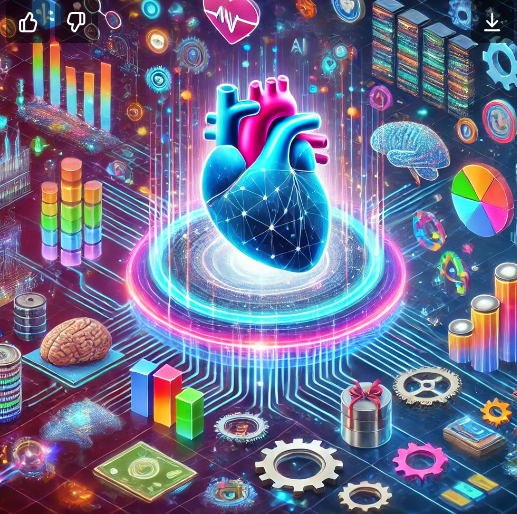In the past few years, Generative AI has exploded onto the global stage as one of the most transformative technologies. From revolutionizing healthcare, finance, and entertainment to its implications in reshaping the future of work and contributing trillions to the global economy, this cutting-edge branch of artificial intelligence is rapidly changing how businesses operate and how humans interact with technology.

What is Generative AI?
Generative AI refers to a type of artificial intelligence that can generate new, previously unseen data by learning patterns and structures from existing datasets. While traditional AI is designed to analyze data and make predictions or automate processes, generative AI goes a step further by creating entirely new content, whether it’s images, text, audio, or even software code. Popular tools like ChatGPT, DALL-E, and MidJourney are prime examples of generative AI in action.
The Economic Potential of Generative AI: A Trillion-Dollar Opportunity
Generative AI has the potential to unlock immense economic value. Analysts from leading consultancies estimate that generative AI could contribute between $2.6 trillion to $4.4 trillion annually to the global economy. This projection is based on generative AI’s ability to increase productivity across various industries by automating creative processes, optimizing value chains, and driving innovation.
For instance, in industries like manufacturing, AI-generated designs and simulations reduce the time and costs associated with prototyping and production. In finance, generative AI is being leveraged to automate trading algorithms, enhance fraud detection, and personalize banking experiences at scale. In healthcare, AI-driven models are generating new drug compounds, streamlining diagnostic processes, and assisting in surgeries. As these industries adopt AI-driven solutions, they will significantly reduce operational costs and increase profitability, contributing to broader economic growth.
Generative AI Across Various Industries
The application of generative AI is not restricted to just one or two industries. Its transformative potential spans across sectors:
- Healthcare: Generative AI has been a game-changer for drug discovery and medical research. AI models are now generating potential drug candidates faster than traditional research methods. Furthermore, AI can help generate synthetic medical data for use in research, protecting patient privacy while still allowing for the advancement of medical knowledge. These breakthroughs are reducing the time it takes to get life-saving treatments to market.
- Finance: In the world of finance, generative AI models are used to create synthetic financial data that can simulate market conditions for risk management and investment analysis. AI algorithms are automating the creation of personalized investment strategies, making financial planning more accessible to the average consumer. Additionally, the ability to detect fraudulent transactions is being enhanced with AI models capable of identifying suspicious activity in real time.
- Manufacturing: In industries where design and production cycles are lengthy, like automotive or aerospace, generative AI is driving efficiency by generating innovative designs, reducing prototyping time, and optimizing supply chains. AI-powered generative design tools allow engineers to input parameters such as weight, materials, and cost, after which the AI generates thousands of design options, optimizing for the best possible solution.
- Entertainment: AI is revolutionizing the entertainment industry with tools that can generate realistic digital environments, characters, and even scripts. Filmmakers are using AI to create visual effects and storylines that would be impossible or time-consuming with traditional methods. Streaming services are employing AI to personalize content recommendations to individual viewers, enhancing user engagement and retention.
Generative AI and Workforce Impact: A New Paradigm for Collaboration
As businesses adopt generative AI, concerns around its impact on the workforce have surfaced. Many fear that widespread automation will lead to job displacement. However, rather than replacing human workers, generative AI is expected to foster collaboration between humans and machines.
The key lies in understanding that AI is a tool designed to augment human capabilities rather than replace them. Creative professionals, such as writers, graphic designers, and marketers, can leverage generative AI to speed up repetitive tasks while focusing more on strategic and high-value work.
For example, content creators can use AI-powered tools like Copy.ai or Jasper to draft initial versions of blog posts, advertisements, and social media content, while they fine-tune the messaging and creativity. This is already visible in industries where AI-generated content is becoming a norm, allowing creators to explore more creative and imaginative work.
Top Generative AI Trends in 2024
As we move into 2024, the following trends are emerging as critical drivers in the generative AI space:
- Advancements in Foundation Models: Large-scale AI models, like GPT-4, are growing even more sophisticated, powering a wide range of AI applications from chatbots to automated video generation.
- Generative AI for Social Good: AI models are being deployed to tackle societal challenges such as climate change, disaster management, and pandemic prediction. AI can generate climate models, simulate potential disaster impacts, and suggest mitigation strategies.
- Governance and Sustainability: With the growing use of generative AI comes the need for proper AI governance. Ethical AI development is becoming a focal point, ensuring that generative AI solutions are developed responsibly and sustainably.
Some Predictions:
- Healthcare Dominance by AI: By 2025, generative AI in healthcare is predicted to cross $70 billion in market size, primarily driven by drug discovery, personalized medicine, and diagnostic tools. With AI reducing the drug development process by half, there is immense potential for reducing treatment costs globally.
- AI in Content Creation: With companies like OpenAI and Google DeepMind pushing the boundaries of text and image generation, the future of content creation will rely heavily on generative AI models. Expect industries like advertising, media, and entertainment to adopt AI-generated content en masse, potentially automating over 30% of creative roles by 2026.
- Manufacturing and AI-Driven Optimization: The manufacturing industry is expected to generate $500 billion in annual value by 2028 through the adoption of generative AI for predictive maintenance, process optimization, and automated design. Companies are already using AI to reduce material wastage and optimize production lines, with the trend set to grow rapidly.
- Generative AI in Retail and E-commerce: Retail and e-commerce will see significant transformation by 2025, with AI being used to create hyper-personalized customer experiences. AI-powered recommendation engines, dynamic pricing models, and automated customer service will be critical in driving online sales. Global retail sales are predicted to grow by $1.5 trillion annually with AI integration.
- Workforce Evolution: Generative AI will redefine how humans interact with machines. By 2030, 50% of all work tasks will be automated or augmented by AI, but experts predict the creation of 97 million new AI-related jobs, particularly in AI ethics, oversight, and development.
Hypothetical Calculation: The Economic Impact of AI on Manufacturing
Let’s assume a mid-sized manufacturing company adopts generative AI to optimize its product design and reduce prototyping costs. The company currently spends ₹10 crore annually on prototyping and design.
By implementing AI-powered generative design:
- The company reduces design time by 50%, saving ₹5 crore annually in design and labor costs.
- The prototyping phase is cut by 60%, saving ₹2 crore annually in material and process costs.
Total savings: ₹7 crore per year, contributing to enhanced productivity and profitability.


